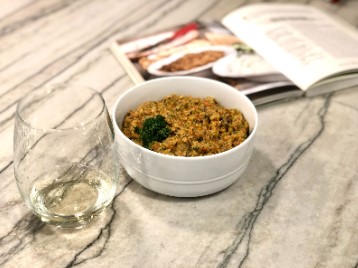Welcome to the new Cooking with Caroline occasional feature on the Becker Building and Remodeling blog! To provide a bit of context, my name is Caroline – I’m Cary’s oldest daughter and Annette’s older sister. You’ve maybe seen me around as an occasional demolition hand on job sites in the summer months, but now Cary and Annette seem to think it’s a good idea to give me an occasional blog post.
Here’s the disclaimer, though: I’m not a professional chef, by any stretch. Let’s not even pretend. But, what I do know is three things: I love cooking, I love cooking for other people, and I love learning about cooking.
So, as I think about our inaugural Cooking with Caroline post, I wanted to pick a recipe that was both approachable (I don’t want you to give up on me before we even start) and flexible (I know we have picky eaters here, it’s all good). The recipe I’m sharing first is one of my favorite ways to usher in our early summer vegetable season in Minnesota – think radishes, peas, early carrots. After what seems like the interminable months of winter, I want to eat vegetables that don’t get stored in a cellar or a jar, and I want to grill on the patio without having to wear copious amounts of clothing just to feel my hands.
The original Soba Noodle Salad (from the April 2015 Cooking Light magazine) calls for both soba (buckwheat) noodles and steamed sugar snap peas, but I don’t particularly enjoy either of those things because they don’t cook up nicely; in my opinion, there are a few ways we can up the game. So, what I’m really sharing with you is my time-tested take-away from this recipe: a yummy pork marinade and a complimentary sauce that can be paired with most any vegetable and grain.
The original recipe calls for slicing a pork loin and marinating it for 30 minutes before grilling, but I’ve found that marinating a whole pork tenderloin overnight and slicing it after grilling makes for more tender and juicy slices. The sauce used for serving can be made in advance and will keep for a couple days in the fridge (I see you, Sunday meal prep people).
In terms of the vegetable to pair with this recipe, I’m partial to spring veggies since this marinade and sauce plays so nicely with early spring flavors – perhaps slice and steam some carrots or chop some fresh (not cooked) snap peas, then add some sliced radishes because they’re a nice crunch with the final dish. You could also add peas (cooked from frozen, or freshly shucked from the farmers’ market and steamed), cooked edamame beans, raw carrot ribbons (use your vegetable peeler), sliced red bell pepper, or steamed broccoli from the freezer – the veggies truly are flexible. In terms of the grain, if you’re not a lover of soba noodles or you’re not familiar with them, I’d recommend brown rice.
So, with that, here’s a great spring recipe! Find some spring veggies, fire up the grill and let me know what you think.
Spring Pork Marinade and Sauce
Marinade (double if using a tenderloin larger than two pounds):
- 2T canola oil (or Olive Oil)
- 2T maple syrup
- 1T brown sugar
- 5 tsp soy sauce or tamari sauce
- 2 tsp fish sauce
- 1 tsp grated ginger (ground ginger is fine)
Place the marinade with a 1-2lbpork tenderloin in a zip-lock bag and let sit in the fridge overnight – turn several times if possible.
Sauce:
- 3tsp soy sauce or tamari sauce
- 2T sesame oil
- 2tsp brown sugar
- 2tsp lemon juice
- ½ tsp crushed red pepper
Make the sauce up to one day ahead, keep in the fridge until you’re ready to serve.
Preparation Instructions:
- When you’re ready to cook, prepare the brown rice or other grain following the directions on the package.
- The meat doesn’t take long to grill, so prepare the sauce and any vegetable prior to grilling (peeling carrots, slicing radishes, etc.)
- When ready, grill the pork tenderloin on a medium hot grill for 12-15 minutes, turning once; use a meat thermometer in the thickest part of the tenderloin and cook to an internal temperature of 140-145°.
- While the meat is cooking, steam or finish cooking the vegetables of your choice.
- When the meat is finished, let it sit, covered in tinfoil, for a few minutes before slicing it.
- Serve with the rice, vegetables, and sauce.
Enjoy!








